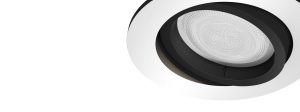Recessed lights, also known as downlights or can lights, sit flush with the ceiling — making them a great lighting solution for small kitchens or kitchens with low ceilings where pendant lights might cause obstructions. The sleek, minimalist design of recessed lighting means they integrate seamlessly with all interior design styles.
How to use recessed kitchen lighting
How far apart should recessed lights be in a kitchen?
The distance between recessed light fittings depends on the size of your kitchen. In smaller kitchens, install recessed lights two to three feet apart to keep lighting uniform. Have a larger kitchen? Install one recessed light for every four to six square feet of ceiling space. Though recessed lights may look small, together they provide strong, consistent light coverage across a whole room.
How many recessed lights do you need in a small kitchen?
To determine how many recessed lights your kitchen needs, first measure the dimensions of your kitchen. Multiply the length by the width to calculate your kitchen’s square footage — then multiply this by 1.5 to find the total wattage needed. Finally, divide this number by the wattage of the bulbs you will use.
If you are using LED bulbs such as Hue downlights, remember that the wattage is much lower than a traditional bulb, and you will need to check what the equivalent wattage is. For example, a Hue 4-inch downlight is 8.5 watts, but its light is equivalent to a 62-watt bulb.
Example: You have 160-square-foot kitchen and 60-watt bulbs.
160 x 1.5 = 240 240 / 60 = 4
In this example, you would need four recessed lights.
Where to place recessed lights in your kitchen
When deciding where to place recessed lights, think about which parts of your kitchen you use for which purpose. For kitchen island lighting, make sure your recessed lights cast sufficient light at this area as it’s
used for food preparation where task lighting is important. It’s also useful to have lights focused on your sink, counters, and stove so that you can easily brighten your workspace or dim it when you’re not cooking.
You can also use recessed lighting to create decorative accents, especially when used to wash the walls — with this effect, you can make the space look brighter or highlight works of art on the wall.

